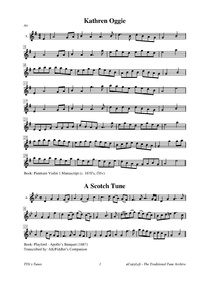Template:Pagina principale/Vetrina

Played by: Julie Petit
Source: Soundcloud
Image: Kerr Crest & Coats of Arms.

The air was credited to Irish harper Rory dall O'Cahan by William Grattan Flood, the Irish antiquarian in his History of Irish Music. Rory dall spent most of his life in Scotland between 1601 and 1650, known to the court of King James in that country; despite this Flood seems anxious to claim the melody as Irish in origin.
Unfortunately, Grattan Flood's work tends to be error-prone, and it is hard to credit any unsubstantiated assertions with much veracity. "Katherine Ogle" (there are numerous spelling variations) appears earliest in the Scottish Panmure Manuscript #9454, c. 1675, Seventy Seven Dances, Songs and Scots Airs for the Violin, and was printed under this title in the Appendix (written in 1688) to Playford's Dancing Master of 1686 (a note called it "a new dance"). On the strength of the Playford publication in the Dancing Master, 1686 edition, the English collector Chappell (1859) disputes the claim of Scottish ancestry.
Chappell (1859), in fact, takes virulent exception to Stenhouse's scholarship regarding this tune after the latter claimed that the air was Scottish and dated it from the year 1680 (when it was sung by Mr. John Abell at a concert in Stationers' Hall). Chappell found that the only date Abell could possibly have sung it was in 1702, and he states that the earliest printing was in the Appendix to the 7th edition of Playford's Dancing Master of 1686 (where it appears under the title "Lady Catherine Ogle"); Chappell, who claimed many Irish and Scottish airs as English, was evidently unaware of the version in the Panmure Manuscript when he accused Stenhouse of being deliberately misleading regarding its national origin. John Glen (1891 and 1900) also disagrees with Chappell, noting that Chappell's own source, John Playford, published the tune a year before it was mentioned in The Dancing Master's appendix (1688) in Apollo's Banquet (5th edition, 1687) where it is called a "Scotch Tune" in footnotes and in fact appears under the title "A Scotch Tune" only. O'Farrell (c. 1806) also listed the melody as "Scotch." J.M. Wood (The Popular Songs and Melodies of Scotland, 1887) also concluded it was Scottish, "from internal evidence."
It appears in one of the earliest Scottish fiddler's manuscript repertory books, c. 1705, in the private collection of Frances Collinson (1971). Early Scottish manuscript versions include the Guthrie Manuscript (c. 1680), the Panmure Violin 1 Manuscript (c. 1670's), and the Leyden Manuscript (c. 1692, though not the exact version given by Playford). The air appears in full in the Guthrie Manuscript (c. 1680's), which was named for Covenanting minister James Guthrie of Stirling, beheaded in 1661 for publishing a seditious pamphlet; it appears in a section of music inserted later in a book of his sermons.
Mary Anne Alburger points out that he was probably no lover of dance music, and that it is possible someone sewed the music into Guthrie's book as a joke.
...more at: Katharine Oggle - full Score(s) and Annotations
